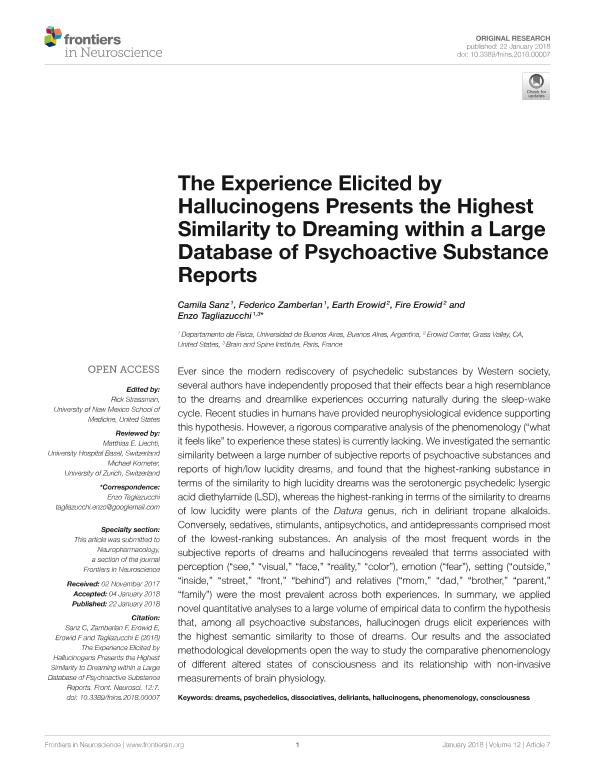Mostrar el registro sencillo del ítem
dc.contributor.author
Sanz, Camila

dc.contributor.author
Zamberlan, Federico

dc.contributor.author
Erowid, Earth
dc.contributor.author
Erowid, Fire
dc.contributor.author
Tagliazucchi, Enzo Rodolfo

dc.date.available
2020-02-05T18:22:30Z
dc.date.issued
2018-01
dc.identifier.citation
Sanz, Camila; Zamberlan, Federico; Erowid, Earth; Erowid, Fire; Tagliazucchi, Enzo Rodolfo; The experience elicited by hallucinogens presents the highest similarity to dreaming within a large database of psychoactive substance reports; Frontiers Media S.A.; Frontiers in Neuroscience; 12; JAN; 1-2018; 1-19
dc.identifier.issn
1662-4548
dc.identifier.uri
http://hdl.handle.net/11336/96759
dc.description.abstract
Ever since the modern rediscovery of psychedelic substances by Western society, several authors have independently proposed that their effects bear a high resemblance to the dreams and dreamlike experiences occurring naturally during the sleep-wake cycle. Recent studies in humans have provided neurophysiological evidence supporting this hypothesis. However, a rigorous comparative analysis of the phenomenology ("what it feels like" to experience these states) is currently lacking. We investigated the semantic similarity between a large number of subjective reports of psychoactive substances and reports of high/low lucidity dreams, and found that the highest-ranking substance in terms of the similarity to high lucidity dreams was the serotonergic psychedelic lysergic acid diethylamide (LSD), whereas the highest-ranking in terms of the similarity to dreams of low lucidity were plants of the Datura genus, rich in deliriant tropane alkaloids. Conversely, sedatives, stimulants, antipsychotics, and antidepressants comprised most of the lowest-ranking substances. An analysis of the most frequent words in the subjective reports of dreams and hallucinogens revealed that terms associated with perception ("see," "visual," "face," "reality," "color"), emotion ("fear"), setting ("outside," "inside," "street," "front," "behind") and relatives ("mom," "dad," "brother," "parent," "family") were the most prevalent across both experiences. In summary, we applied novel quantitative analyses to a large volume of empirical data to confirm the hypothesis that, among all psychoactive substances, hallucinogen drugs elicit experiences with the highest semantic similarity to those of dreams. Our results and the associated methodological developments open the way to study the comparative phenomenology of different altered states of consciousness and its relationship with non-invasive measurements of brain physiology.
dc.format
application/pdf
dc.language.iso
eng
dc.publisher
Frontiers Media S.A.

dc.rights
info:eu-repo/semantics/openAccess
dc.rights.uri
https://creativecommons.org/licenses/by/2.5/ar/
dc.subject
CONSCIOUSNESS
dc.subject
DELIRIANTS
dc.subject
DISSOCIATIVES
dc.subject
DREAMS
dc.subject
HALLUCINOGENS
dc.subject
PHENOMENOLOGY
dc.subject
PSYCHEDELICS
dc.subject.classification
Otras Ciencias Físicas

dc.subject.classification
Ciencias Físicas

dc.subject.classification
CIENCIAS NATURALES Y EXACTAS

dc.title
The experience elicited by hallucinogens presents the highest similarity to dreaming within a large database of psychoactive substance reports
dc.type
info:eu-repo/semantics/article
dc.type
info:ar-repo/semantics/artículo
dc.type
info:eu-repo/semantics/publishedVersion
dc.date.updated
2019-10-22T17:30:38Z
dc.identifier.eissn
1662-453X
dc.journal.volume
12
dc.journal.number
JAN
dc.journal.pagination
1-19
dc.journal.pais
Suiza

dc.journal.ciudad
Lausana
dc.description.fil
Fil: Sanz, Camila. Consejo Nacional de Investigaciones Científicas y Técnicas. Oficina de Coordinación Administrativa Ciudad Universitaria. Instituto de Física de Buenos Aires. Universidad de Buenos Aires. Facultad de Ciencias Exactas y Naturales. Instituto de Física de Buenos Aires; Argentina
dc.description.fil
Fil: Zamberlan, Federico. Consejo Nacional de Investigaciones Científicas y Técnicas. Oficina de Coordinación Administrativa Ciudad Universitaria. Instituto de Física de Buenos Aires. Universidad de Buenos Aires. Facultad de Ciencias Exactas y Naturales. Instituto de Física de Buenos Aires; Argentina
dc.description.fil
Fil: Erowid, Earth. Erowid Center; Estados Unidos
dc.description.fil
Fil: Erowid, Fire. Erowid Center; Estados Unidos
dc.description.fil
Fil: Tagliazucchi, Enzo Rodolfo. Consejo Nacional de Investigaciones Científicas y Técnicas. Oficina de Coordinación Administrativa Ciudad Universitaria. Instituto de Física de Buenos Aires. Universidad de Buenos Aires. Facultad de Ciencias Exactas y Naturales. Instituto de Física de Buenos Aires; Argentina. Brain and Spine Institute; Francia
dc.journal.title
Frontiers in Neuroscience
dc.relation.alternativeid
info:eu-repo/semantics/altIdentifier/doi/http://dx.doi.org/10.3389/fnins.2018.00007
dc.relation.alternativeid
info:eu-repo/semantics/altIdentifier/url/https://www.frontiersin.org/articles/10.3389/fnins.2018.00007/full
Archivos asociados
